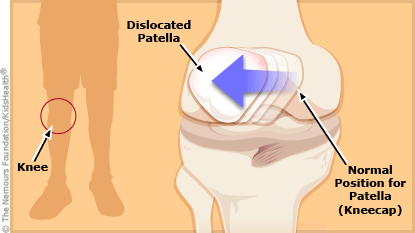Dislocated Kneecap (Dislocated Patella)
Article Translations: (Spanish)
What Is a Dislocated Kneecap?
A dislocated kneecap is when the bone in the front of the knee — called the kneecap or patella — slides out of place.
What Are the Signs & Symptoms of a Dislocated Kneecap?
Common symptoms of a dislocated kneecap or dislocated patella (peh-TELL-uh) include:
- feeling like the knee buckled or “gave out”
- sudden, severe pain and swelling
- a bump noticed on the outside of the knee. This is the kneecap that is out of place.
- the knee is held in a bent position
- bruising around the knee

How Does a Dislocated Kneecap Happen?
The kneecap sits on the front of the knee joint. When the knee is bent and straightened, the kneecap slides up and down in a groove in the front of the knee. A direct blow to the knee, such as in a fall or an accident, can push the kneecap out of the groove, or dislocate it. The kneecap also can dislocate when the knee gets twisted during sports or play.
A dislocated kneecap can happen to any child or teen who has a blow or twist to the knee. Some kids have conditions that make them more likely to dislocate the kneecap. These include things like some leg muscles being stronger than others or loose ligaments (bands of tissue that hold bones together at joints).
How Is a Dislocated Kneecap Diagnosed?
Often, doctors can tell there is a dislocated kneecap by asking questions and looking at the knee. X-rays aren’t needed for a diagnosis, but are done after the kneecap is back in place to check for small fractures in the bone. These can happen as the kneecap slides out of its groove and then back into place.
How Is a Dislocated Kneecap Treated?
A person with a dislocated kneecap needs care at the hospital right away. After giving pain medicine, the doctor or another health care provider will gently slide the kneecap back into place while straightening the leg. This quick maneuver is called a reduction. Then, they’ll order an X-ray to check for fractures.
Sometimes a dislocated kneecap may move back into place on its own if the child straightens the leg before getting to the hospital. If this happens, the doctor will still get an X-ray to check the knee for fractures.
After a kneecap is back in place, a child will need to wear a knee immobilizer (a brace that keeps the knee straight) on the knee for a few weeks and avoid activities that cause pain, such as walking, standing, and repetitive bending. Kids and teens may need crutches to help with walking. Physical therapy and strengthening exercises help to heal the knee. Often, a person will go see an orthopedic provider (bone specialist) to make sure the knee is healing well.
What Else Should I Know?
After dislocating a kneecap, kids and teens must stay out of sports and other physical activities for a few weeks. Most kids can return to these in about 4–6 weeks with therapy and exercises to build strength. Some kids might need to also use a supportive knee wrap or athletic brace during sports for a while. Your care team will let you know when your child is ready.
To help your child heal as quickly as possible, follow the doctor’s advice about:
- which activities to avoid
- which activities are OK (for example, swimming may be fine while your child heals)
- strengthening exercises
- going to all follow-up doctor visits
Talk to your health care provider about ways to prevent a future dislocation, such as:
- stretching before and after sports
- working to strengthen the leg muscles
These steps also can help protect against other injuries.
Note: All information is for educational purposes only. For specific medical advice, diagnoses, and treatment, consult your doctor.
© 1995-2024 KidsHealth ® All rights reserved. Images provided by iStock, Getty Images, Corbis, Veer, Science Photo Library, Science Source Images, Shutterstock, and Clipart.com

